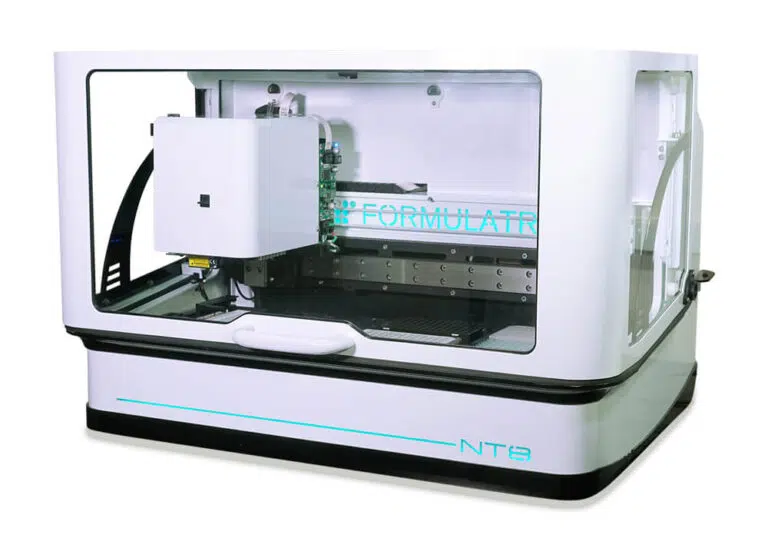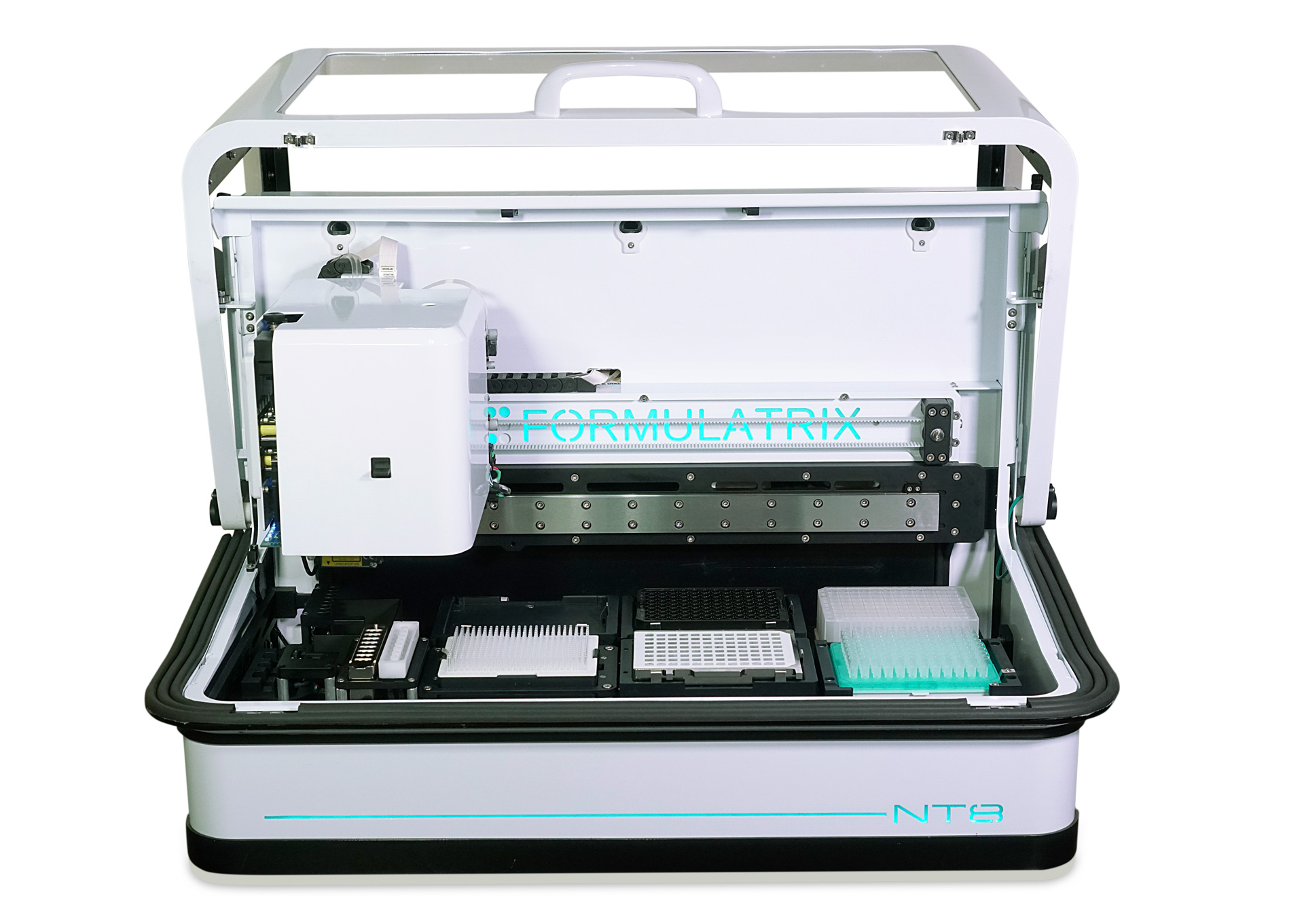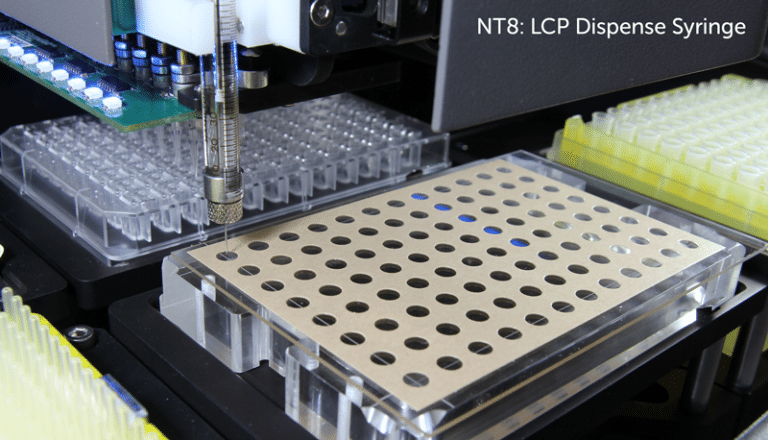Drop Setter for Protein Crystallization - NT8®
Attribute:
SKU : NT8
Categories : 12. Lab Equipment , Formulatrix ,
Brand : Formulatrix
Share
Save Money + Reduce WasteReusable Dispensing TipsSet drops for a 96-well plate using only 8 tips, washing between steps. | Maintain Protein Drop IntegrityProportional Active HumidificationPrevent sample evaporation and increase experiment reproducibility. | Set-Up Plates in a Cold RoomCold Room Compatible Set up crystallization plates at any temperature including 4°C. |
Reliable Drop Setting: Reduce Costs and Increase Reproducibility
The NT8® - Drop Setter is a fast, nanoliter-volume liquid handler with drop dispensing capability, including setting drops for Lipidic Cubic Phase (LCP) experiments. The 8-tip head aspirates and dispenses drops from 10 nL to 1.5 μL.
Benefits:
|  |
 |
|
Clean Drop Release with Flexible Fingers
In order to ensure that drops wick to the crystallization plate, all eight tips must touch the plate. To achieve this, each tip is attached to a flexible finger that can independently travel +/- 0.5 mm vertically, enabling the dispense head to contour to the surface of each well. To protect your plate and sample, each tip has a sensor that indicates when the tip contacts the plate's surface. These sensors allow the NT8 to drive down precisely to the point where all tips touch the plate without damaging your plate or sample. The NT8 then retracts slightly away from the surface - yielding the perfect dispense gap for setting drops. This enhancement improves drop precision and reduces the chance of bubbles.
"Viva Biotech has been working with the NT8 system for over 8 years. The preliminary crystallization screening is known as crucial but strenuous in early-stage crystallization. NT8 helps set up the crystallization trays fast and precisely, releasing our scientists from the tedious liquid-dispensing work. Moreover, small droplet handling with the full-automatic humidifier can save valuable protein compared with manual pipetting. The new NT8 v4 added water level monitoring and waste tip reminder for careless users. This prompt information helps us train new scientists. With the increased concern for life science in recent years, projects are also blooming at Viva. The reservation of the NT8 has been almost full in the past few months and a new machine is just on the road!"
| Fan Jiang Director, Crystallography |
Set Up 24-Well Plates with Ease
The NT8 provides full support of 24-well crystallization plates for both sitting and hanging drop experiments. Multiple drops can be designated per well based on your experimental needs. This automated setup enables precise drop setting for better experiment reproducibility over hand pipetting while reducing time at the bench.
|
|
NT8 Drop Setter / Crystallization Robot

"We make great use of the NT8 in optimization experiments at the National High-Throughput Crystallization Center - the best part is the humidity control during drop setting!"
 | Sarah Bowman Associate Investigator and Director |
Prevent Drop Evaporation and Increase Reproducibility
Proportionally-Controlled Active Humidificatio
The NT8 prevents sample evaporation with three powerful, fully-enclosed humidifiers that actively control humidity from ambient up to 95%. You can set humidity on/off manually or “set it and forget it” and let the NT8 do the work. The system has tight control of the humidity with a variance of only +/- 2%.
The NT8 Drop Setter can increase humidity from 60% to 85% in under 20 seconds. The humidifiers are positioned away from active samples so your drops are protected from condensation and buildup.
No need to mop up excess water around your plates.
Proportionally-Controlled Humidification
The system automatically regulates how many of the humidifiers are on to give a precise, even humidification throughout. For example, when the humidification is within 5% of the target then only one humidifier will turn on.
Don't Worry About Running Out of Water for Humidification
The NT8 uses a minute amount of water while maintaining a relative humidity of 85%. This coupled with a 5-gallon reservoir means that you won't run out of humidification during a dispense or need to refill the deionized water very often.
Flexible for a Variety of Protein Crystallization Experiments
Vapor Diffusion Utilizes solvent evaporation to induce | Microbatch The sample and reagent are combined | Micro-dialysis Employs a semi-permeable membrane | Seeding Nucleates / promotes crystal growth by |
Additive Identifies additives to enhance crystalsize, quality, and diffraction properties by testing a wide range of combinations | Antigen-antibody Aids in understanding interactions and reveals the molecular recognition underlying antibody-antigen binding | LCP Utilizes a specialized lipidic cubic phase matrix as a crystallization medium to obtain membrane protein crystals | Bicelle Employs disk-like structures formed by long-chain and short-chain phospholipids for favorable stabilization and crystallization |
 | Connie Darmanin Research Scientist |
The NT8’s pipette tips feature a very small geometry and are made of a hydrophobic material, ensuring precise dispensing across the full range of buffers and reagents encountered in protein crystallization.
With the low volume tips, the system uses liquid displacement pipetting, which means the tips can be quickly washed from the inside out and reused or discarded for zero cross-contamination. The choice is yours.
 | Sirano Dhe-Paganon Director and Principal Scientist |
Microseeding has been used routinely for optimization by protein crystallographers for many years. However, seed dispensing is an additional step to the workflow and takes longer than conventional screen setup. For best results, both the seed stock and the seeding plate need to be kept in a tightly humidity-controlled environment.
The NT8 can automatically dispense seeds as low as 10 nL in volume with high accuracy and precision. The system also prevents sample evaporation with three powerful fully enclosed PID-controlled humidifiers that actively control humidity, making it well-suited for micro and matrix-seeding experiments.
"Our NT8 drop setter has proven to be an invaluable asset to our crystallographic work and has become a real workhorse instrument in our lab. Not only does it allow us to test twice as many conditions in half the time (if not more), but it is easily adapted to more customized applications such as screening drop ratios or using additives. We continue to receive prompt, personalized support from Formulatrix and benefit from their constant improvements to both the NT8 and its software. We are very pleased with our experience thus far, and would highly recommend the NT8 to anyone interested in automated crystallization screening."
 | Kip Guja Scientist |
Automatically Calibrate Your System within Minutes
Gone are the days of strenuous and time-consuming instrument calibration. Simply place a calibration plate on the NT8 and let the system automatically calibrate itself using a laser-aided calibration system.
"Our facility often receives small amounts of purified protein samples. The Formulatrix NT8 pipetting robot allows screening for conditions using extremely small volumes. The robot pipettes these volumes with high accuracy, ensuring high-quality crystallization experiments. We have used the NT8 for years, and when it came time to renew our system, it was very clear that a Formulatrix pipetting system would be purchased again."
 | Dr. Sander Smits apl. Professor |
Plate Copy Option
The NT8’s plate copy option, used for creating daughter plates from deep well blocks, automatically loads tips and can aspirate and dispense up to 200 μL from the block to up to 3 daughter plates.
The plate copy head accurately detects when each tip contacts liquid, allowing the NT8 to aspirate from just below the liquid surface to prevent viscous liquids from coating the outside of the tips and dripping while in transit.
Lipidic Cubic Phase (LCP) Dispensing Made Easy
LCP Option
The NT8’s LCP option can accurately and quickly dispense LCP drops as small as 30 nL. Its fully-automated calibration system ensures that the syringe tip is centered within 50 µm of the target drop location for a perfect overlay of the screen on protein. Dispensing LCP and well solution drops to a 96-drop LCP plate takes less than 7 minutes.
The LCP option includes several components that add to the NT8’s functionality:
- An 8 mm barrel LCP syringe holder
- An LCP syringe mixing station with configurable mixing cycles
- A calibration station to ensure precise dispense
The Art of Lipidic Cubic Phase (LCP)
Drop Setting
Automated drop setters are common in most laboratories and provide the automation necessary for routinely setting up crystallization plates containing soluble proteins. Unfortunately, extending their use to encompass Lipidic Cubic Phase (LCP) drop setting is not trivial. The LCP medium is highly viscous, making it difficult to dispense reproducible drops in a timely manner. Conditions including syringe pressure, tip displacement, drop volume, dispensing speed, and evaporation rate all impact the reproducibility of LCP drop setting. The recent introduction of LCP-specific drop setters, including the NT8® by FORMULATRIX® , has finally enabled reliable, automated LCP drop setting.

In the case of the NT8, the velocity of the syringe plunger, and the delay before moving the stage are carefully optimized in order to set uniform drops. The compression forces experienced by the LCP medium vary with the speed at which the plunger is actuated, resulting in medium dispensing after the plunger has stopped moving. In the NT8, the delay before moving the tip away from the plate after the plunger has been actuated is carefully calibrated, resulting in uniform and reproducible drops.
Due to the high viscosity of the medium, LCP dispensing is more time-consuming than soluble-protein drop setting. In general, dispensing of soluble proteins in a 96 well plate takes about 2 minutes, whereas the same operation utilizing LCP requires about 7 minutes. The longer times required cause evaporation to become a greater issue than during conventional drop setting. In order to combat evaporation during dispensing, the NT8 employs three individual ultrasonic humidifiers that control the relative humidity of the environment up to 95%
"I’m the primary user on the NT8 in my lab. I’ve used several different drop setting robots and I can tell you this machine is my favorite. The humidity is a nice feature I can add my trays and let the machine go without fear of it drying out, this allows me to multitask stress-free when running the NT8 as it mixes my protein and solutions. Additionally, I always will make three trays from deep well aliquots and not having to reseal them is also a plus. The tip usage is somewhere in between the mosquito and the phoenix, but I feel like it’s found a good balance here and the waste is an acceptable amount. I’m ok with some waste as having all reusable tips can be quite the hassle as tips can break and require regular cleaning. Drop setting on this machine has always been perfect and hassle-free. I’ve had errors on both the phoenix and mosquito and I had to watch the machines to make sure they ran as expected. With the NT8 I can set drops without worry and have stopped my habit of babysitting the robot. Priming the system is also a breeze, having turbine pumps is much easier than a pressure based system. If I had to have one complaint it the amount of water the machine goes through, but perhaps this problem could be solved with a slightly larger Dewar."
 | Connor Weidle Research Technician |
https://formulatrix.com/protein-crystallization-systems/nt8-drop-setter/






